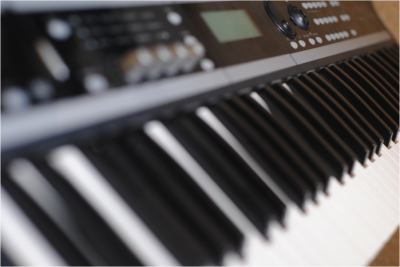The learning curve for new a keys player in a worship team is often steep. Additionally worship team leaders can become frustrated that they are not able to communicate what they want or help their keys players when they run into a roadblock. Hopefully this post will clear up some of the confusion by defining some basic keyboard technology terms.
Sample/Patch/Voice/Program – The sounds that a keyboard expresses. Samples are typically pre-recorded instruments or sounds. For example many keyboards have sampled grand piano sounds via studio microphone recording for pristine reproduction of these instruments. Patches, voices, and programs are all relatively interchangeable terms used to describe sounds that are generated by the keyboard’s internal programming.
Monophonic – Typically, early synthesizers were monophonic, meaning you could only play a single note at a time.
Polyphonic – The ability to be able to play multiple notes simultaneously like in a chord.
Multitimbral – The ability to play or layer several keyboard voices on top of each other.
Split – Dividing 2 or more sounds across a keyboard into distinct sections for independent playing. For example if you wanted to cover a bass guitar sound with your left hand and a piano sound with your right hand on the same keyboard.
Layer – Overlapping 2 or more sounds which you play and are expressed simultaneously.
*Note that the majority of today’s stage pianos and workstations are polyphonic and multitimbral with a variety of split and layering capabilities.
MIDI – Musical instrument digital interface. MIDI is the electronic “language” that allows communication between keyboards, computers, and other electronic musical devices. The most basic utilization of MIDI typically is along these lines.
Let’s say you prefer playing on an 88 key weighted keyboard, this is your controller or master keyboard, and you have a sound onboard a computer via a DAW (digital audio workstation, i.e.: Ableton, Mainstage, etc) or another slave keyboard that you want to play. Essentially you want to be able to play the master keyboard and have the slave software or keyboard output its own sounds as if you were playing it. Which notes are being pressed, the velocity of the notes pressed, and other elements such as a sustain pedal being on or off are communicated and expressed accordingly via MIDI.
Controller/Master keyboard – A keyboard or device without any built-in sounds but is able to send MIDI (MIDI out) data to other keyboards of devices.
Slave keyboard – The keyboard, computer, or device which contains the sound you want to receive MIDI (MIDI in) data into and express via audio.
Loop – A continuous prerecorded or programmed sound that is played in the background underneath what everyone else is playing. May or may not be controlled from the keyboard depending on the specific use.
Soft synth – A software synthesizer program run from a computer and controlled via MIDI by a keyboard. Can be a component within a DAW software package.
VST – Virtual studio technology or a software instrument or effects package which can run inside of a DAW.
Sequencing – A keyboard with sequencing capabilities can record several tracks of digital performances and play them back simultaneously. This is a powerful tool for key players who are covering several different parts. The fact that the performance is made of data and not audio signals allows for synchronization with what the rest of the team is playing, if you are using a click track for example.
Sound Module – Typically, a device or rack-mount box containing the sounds of a keyboard without the keyboard notes present. A sound module is almost always used as the MIDI Slave device by providing the sounds played from another keyboard.
Hopefully this will be a good reference for musicians dipping their toes into the world of keys playing. Feel free to comment with other questions or discussions about tech queries.



